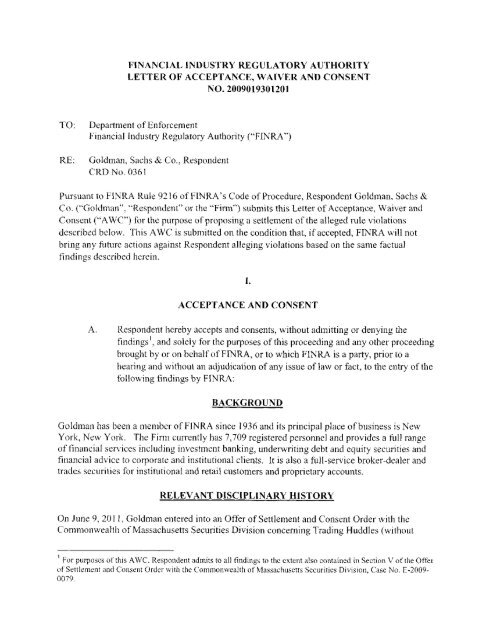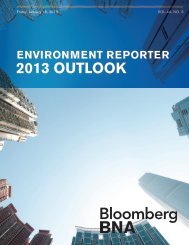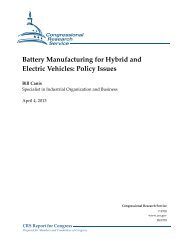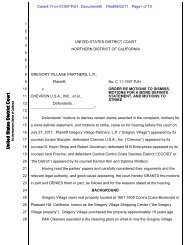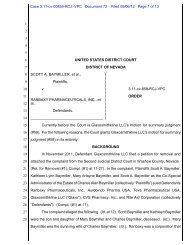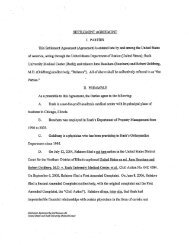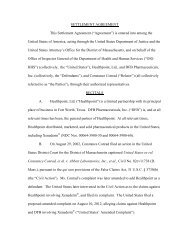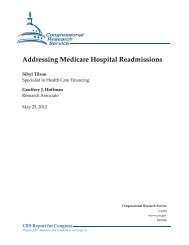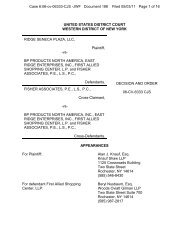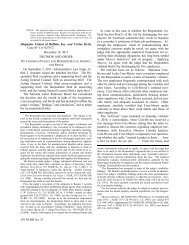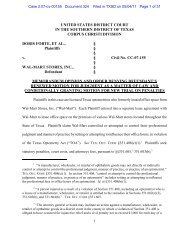Acceptance Waiver and Consent - BNA
Acceptance Waiver and Consent - BNA
Acceptance Waiver and Consent - BNA
You also want an ePaper? Increase the reach of your titles
YUMPU automatically turns print PDFs into web optimized ePapers that Google loves.
FINANCIAL INDUSTRY REGULATORY AUTHORITY<br />
LETTER OF ACCEPTANCE, WAIVER AND CONSENT<br />
NO. 2009019301201<br />
TO:<br />
RE:<br />
Department of Enforcement<br />
Financial Industry Regulatory Authority ("FINRA")<br />
Goldman, Sachs & Co., Respondent<br />
CRD No. 0361<br />
Pursuant to FINRA Rule 9216 of FINRA's Code of Procedure, Respondent Goldman, Sachs &<br />
Co. ("Goldman", "Respondent" or the "Firm") submits this Letter of <strong>Acceptance</strong>, <strong>Waiver</strong> <strong>and</strong><br />
<strong>Consent</strong> ("AWC") for the purpose of proposing a settlement of the alleged rule violations<br />
described below. This AWC is submitted on the condition that, if accepted, FINRA will not<br />
bring any future actions against Respondent alleging violations based on the same factual<br />
findings described herein.<br />
I.<br />
ACCEPTANCE AND CONSENT<br />
A. Respondent hereby accepts <strong>and</strong> consents, without admitting or denying the<br />
findings', <strong>and</strong> solely for the purposes of this proceeding <strong>and</strong> any other proceeding<br />
brought by or on behalf of FINRA, or to which FINRA is a party, prior to a<br />
hearing <strong>and</strong> without an adjudication of any issue of law or fact, to the entry of the<br />
following findingsby FINRA:<br />
BACKGROUND<br />
Goldman has been a member of FINRA since 1936 <strong>and</strong> its principal place of business is New<br />
York, New York. The Finn currently has 7,709 registered personnel <strong>and</strong> provides a full range<br />
of financial services including investment banking, underwriting debt <strong>and</strong> equity securities <strong>and</strong><br />
financial advice to corporate <strong>and</strong> institutional clients. It is also a full-service broker-dealer <strong>and</strong><br />
trades securities for institutional <strong>and</strong> retail customers <strong>and</strong> proprietary accounts.<br />
RELEVANT DISCIPLINARY HISTORY<br />
On June 9, 2011, Goldman entered into an Offer of Settlement <strong>and</strong> <strong>Consent</strong> Order with the<br />
Commonwealth of Massachusetts Securities Division concerning Trading Huddles (without<br />
1<br />
For purposes of this AWC, Respondent admits to all findings to the extent also contained in Section V of the Offer<br />
of Settlement <strong>and</strong> <strong>Consent</strong> Order with the Commonwealth of Massachusetts Securities Division, Case No. E-2009-<br />
0079.
admitting or denying the Legal Conclusions <strong>and</strong> Violations set out in Sections VI <strong>and</strong> VII of the<br />
Order). Commonwealth of Massachusetts Securities Division (Case No. E-2009-0079). The<br />
Massachusetts Securities Division found that between January 1, 2006 through June 9, 2011,<br />
Goldman failed in the respects described in the Order (1) to establish adequate policies <strong>and</strong><br />
procedures relating to potential conflicts of interest with respect to its research services; (2) to<br />
establish adequate procedures relating to the dissemination of certain unpublished short-term<br />
trading ideas to certain priority clients; (3) to reasonably supervise equity analysts'<br />
communications relating to the dissemination of certain unpublished short term trading ideas; (4)<br />
to prevent the use <strong>and</strong> dissemination by equity analysts of certain unpublished short term trading<br />
ideas; <strong>and</strong> (5) to deal fairly <strong>and</strong> objectively with all clients in connection with the dissemination<br />
of certain unpublished short term trading ideas by its equity research analysts.<br />
Pursuant to the Offer of Settlement <strong>and</strong> <strong>Consent</strong> Order, the Firm agreed to a civil penalty in the<br />
amount of $10,000,000 <strong>and</strong> to an undertaking to (1) permanently discontinue the Firm's<br />
Asymmetric Service Initiative (as defined in the Order); (2) permanently discontinue its Trading<br />
Huddles (as defined in the Order); <strong>and</strong> (3) review <strong>and</strong> modify (as needed) its written supervisory<br />
policies <strong>and</strong> procedures with respect to certain research activities.<br />
The Firm has no other relevant disciplinary history.<br />
OVERVIEW<br />
Pursuant to a formalized business process at the Firm known as "Trading Huddles" as well its<br />
"Asymmetric Service Initiative," the Firm's equity research analysts typically met on a weekly<br />
basis with traders who interfaced with clients, <strong>and</strong> sometimes with equity salespersons, to<br />
discuss the analysts' views, including, among other things, actionable trading ideas, on covered<br />
companies <strong>and</strong> industries in their sector. After such meetings, the research analysts made<br />
telephone calls to a select group of the Finn's high priority clients to cover the topics discussed<br />
at Trading Huddles, including among other things, the actionable trading ideas shared during the<br />
Trading Huddles. In certain instances, an analyst participated in a Trading Huddle while in the<br />
process of considering changing the published research rating or Conviction List status of a stock<br />
discussed during the Trading Huddle. The Trading Huddle process created the significant risk<br />
that material non-public information concerning the analyst's published research could be<br />
disclosed to certain priority clients.<br />
Between January 2007 <strong>and</strong> August 2009 (the relevant period), the Firm did not have adequate<br />
policies <strong>and</strong> procedures relating to Trading Huddles despite the substantial risk that the Trading<br />
Huddle process could lead to the dissemination of material non-public information concerning<br />
the analysts' published research to the Firm's clients.<br />
In addition to the deficiencies with respect to its supervision of Trading Huddles, the Firm lacked<br />
adequate systems <strong>and</strong> procedures to prevent <strong>and</strong> detect information breaches by its research<br />
analysts or to monitor for possible trading in advance of published ratings changes <strong>and</strong><br />
Conviction List changes. Without a reasonable supervisory system to monitor trading, the Firm<br />
failed to identify <strong>and</strong>/or investigate certain questionable trades executed prior to changes to its<br />
published ratings or changes to its Conviction List. Based on the foregoing, the Firm violated<br />
2
NASD Rules 3010 <strong>and</strong> 2110 <strong>and</strong> FINRA Rule 2010.<br />
Goldman also failed to establish <strong>and</strong> maintain policies <strong>and</strong> procedures reasonably designed to<br />
prevent trading ahead of research reports, in violation of FINRA Rules 5280 <strong>and</strong> 2010.<br />
1. Goldman's Equity Research Division<br />
FACTS<br />
Goldman research analysts responsible for covering equity securities in the United States,<br />
Canada, <strong>and</strong> Latin America are part of the Finn's Americas Equity Research Group, which is<br />
within the Global Investment Research division ("GIR"). The Americas Equity Research group<br />
is divided into six (previously seven) subject-matter sectors. The Firm publishes coveragerelative<br />
investment ratings (Buy, Neutral, or Sell), <strong>and</strong> target share prices (generally for a 6-12<br />
month time horizon), as well as earnings estimates with respect to all covered stocks within each<br />
of the sectors. Changes to the Firm's published investment ratings of covered stocks are<br />
considered material information <strong>and</strong> cannot be made without the review <strong>and</strong> approval of GIR's<br />
Investment Review Committee ("IRC").<br />
During the relevant period, the Firm also published an Americas Conviction List ("Conviction<br />
List"), a "focused list of [Goldman's] best ideas" of its equity research analysts that designates as<br />
Conviction Buy <strong>and</strong> Sell a subset of equity securities that the Firm has rated Buy or Sell. As<br />
with ratings changes, additions to, or removals from, the Firm's Conviction List are considered<br />
material information <strong>and</strong> require IRC review <strong>and</strong> approval.<br />
Throughout the time it conducted Trading Huddles, the Firm considered analysts' commercial<br />
impact (in addition to other performance measures such as accuracy <strong>and</strong> quality of research <strong>and</strong><br />
internal as well as client evaluations) as an important factor in its performance evaluation<br />
process. Goldman evaluates research analysts using an Analyst Scorecard ("Scorecard"), which<br />
reflects overall analyst performance <strong>and</strong> is used to determine the bonuses paid to analysts. The<br />
Scorecard incorporates various components of performance including the accuracy <strong>and</strong> quality of<br />
research, evaluations from internal Goldman personnel (including sales persons <strong>and</strong> traders), as<br />
well as feedback received directly from Goldman institutional investor clients through a process<br />
known as "broker votes." The Firm made clear to analysts the importance of Trading Huddles<br />
<strong>and</strong> the Asymmetric Service Initiative to their performance evaluations which could in turn<br />
affect their compensation.<br />
2. Goldman's Trading Huddles <strong>and</strong> Asymmetric Service Initiative<br />
Goldman implemented a formalized business process known as "Trading Huddles" in 2006.<br />
Trading Huddles were internal meetings, organized by industry sector, among equity research<br />
analysts from GIR <strong>and</strong> traders from Goldman's Securities Division who interfaced with clients<br />
(including market-making <strong>and</strong> client facilitation traders). Access to the Trading Huddles was not<br />
restricted to those individuals, however, <strong>and</strong> may have included clients on certain occasions.<br />
Trading Huddles were a wide ranging activity for the Firm, <strong>and</strong> the Firm devoted a significant<br />
amount of resources to them. From 2006 to 2011, Trading Huddles typically occurred on a<br />
3
weekly basis for each of the six to seven industry sectors during which numerous analysts<br />
discussed thous<strong>and</strong>s of stocks in varying detail.<br />
During Trading Huddles, equity research analysts provided their views, including, among other<br />
things, trading ideas, on covered companies <strong>and</strong> industries in their sector. In fact, analysts were<br />
encouraged to discuss their "highest conviction ideas in that sector" with a focus on<br />
"commercially oriented trading ideas" during Trading Huddles <strong>and</strong> thereafter during calls with<br />
clients.<br />
To enhance the usefulness of its Trading Huddles Goldman implemented a program in January<br />
2007 known as the Asymmetric Service Initiative ("ASI"), through which it provided the<br />
information shared in a structured format in Trading Huddles to approximately 180 high priority<br />
clients selected by the Firm's institutional sales group ("ASI clients"). ASI clients were typically<br />
large hedge funds <strong>and</strong> other institutional investors. As part of ASI, research analysts often<br />
prepared "huddle scripts" regarding the topics discussed at Trading Huddles <strong>and</strong> were instructed<br />
to work from the scripts when speaking to ASI clients. When making ASI calls, analysts were<br />
told to "lead with trading color . . . <strong>and</strong> with the most interesting <strong>and</strong> actionable ideas." The<br />
Firm intended ASI, among other things, to generate increased trading commissions from ASI<br />
clients. The Firm did not disclose to its other clients that it was providing the ASI service to its<br />
priority clients, but analysts were also permitted to discuss the ideas from Trading Huddles with<br />
non-ASI clients.<br />
In certain instances, equity research analysts would discuss a stock during a Trading Huddle at a<br />
time when the analyst was in the process of considering changing the published research rating<br />
or the Conviction List status of that stock. Under the Firm's procedures, equity research analysts<br />
were not prevented from seeking approval for research rating <strong>and</strong> Conviction List changes prior<br />
to or immediately following the discussion of such stock at a Trading Huddle. The Firm<br />
sometimes approved changes to the analyst's published rating on a particular stock shortly<br />
following a Trading Huddle in which such stock was discussed.<br />
Analysts sometimes shared with ASI clients their views about the potential price reactions of a<br />
stock in response to specific anticipated events. In certain instances, an analyst would opine to<br />
priority clients that the price of a security would move in a direction contrary to the published<br />
rating of the stock in response to such an event.<br />
The formalized Trading Huddle <strong>and</strong> ASI process created a significant risk that material nonpublic<br />
information concerning analysts' published research, including previews of rating changes<br />
or changes to Conviction List status, could be disclosed to certain priority clients.<br />
Both the Trading Huddles <strong>and</strong> the ASI programs were discontinued in 2011.<br />
3. Goldman's Inadequate Systems <strong>and</strong> Procedures to Supervise Trading Huddles <strong>and</strong><br />
ASI<br />
After creating the Trading Huddles <strong>and</strong> ASI programs, Goldman failed to adequately address the<br />
increased risks resulting from these programs. Between January 2007 <strong>and</strong> August 2009, the<br />
Firm did not have policies relating specifically to Trading Huddles despite a serious risk <strong>and</strong><br />
4
opportunity that material non-public information concerning analysts' published research could<br />
be disclosed to the Firm's clients.<br />
The Firm Lacked Adequate Systems <strong>and</strong> Procedures to Monitor Communications in<br />
Trading Huddles<br />
During the relevant period, the Firm failed to establish controls reasonably designed to monitor<br />
communications in the Trading Huddles. GIR Compliance personnel regularly participated in<br />
the Trading Huddles from January 1, 2007 through July 31, 2008, but attended less frequently<br />
thereafter. Compliance personnel were typically not informed ahead of time of the stocks that<br />
were to be discussed in an upcoming Trading Huddle, nor were Compliance personnel made<br />
aware of proposed or approved research changes for stocks that might be discussed in Trading<br />
Huddles. Such information would have assisted Compliance personnel in determining whether<br />
an analyst had previewed material non-public changes to the analyst's published research during<br />
the Trading Huddle.<br />
The Firm also did not adequately review discussions in the Trading Huddles to determine<br />
whether there was a possible preview of an upcoming research change by an equity research<br />
analyst during a Trading Huddle regardless of whether there was such a preview.<br />
• In late 2008, the day before a Trading Huddle, a research analyst received<br />
authorization to add Company A to the Firm's Conviction Buy List. The next<br />
day, the analyst stated in a Trading Huddle that Company A "remains our<br />
analyst's favorite idea given a favorable strategic position for the evolving shift of<br />
certain CDS products from the OTC market to a cleared exchange." The Firm<br />
published a report adding the stock to the Firm's Conviction Buy List the day<br />
following the Trading Huddle.<br />
• A research analyst discussed Company B in a Trading Huddle in mid-2008,<br />
stating that "we expect companies with consumer <strong>and</strong> small business exposure to<br />
be under pressure in the current environment, including [Company B]." The next<br />
day, the analyst sought <strong>and</strong> received approval to downgrade Company B from<br />
Neutral to Sell <strong>and</strong> to add the stock to its Conviction Sell List. Goldman<br />
published a report making these changes that same day.<br />
• During a Trading Huddle in the fall of 2008, a research analyst stated that "For<br />
longer term investors, [Company C] looks very attractive at this level." The next<br />
day, the analyst sought <strong>and</strong> received authorization to upgrade Company C from<br />
Neutral to Buy <strong>and</strong> to add the stock to the Firm's Conviction Buy list. Goldman<br />
published a report making these changes the following day.<br />
The Firm Lacked Procedures to Ensure Adequate Records Were Maintained of Huddle<br />
Discussions<br />
The Firm failed to establish a reliable system to memorialize the discussions during the Trading<br />
Huddles. In January 2008, the Firm made "Huddle Champions" (the equity research analysts<br />
5
primarily responsible for organizing a Trading Huddle) responsible for maintaining a record of<br />
the ideas discussed in the Trading Huddle. However, the Firm failed to establish controls to<br />
ensure that the designated person was in fact creating such a record. In certain instances the<br />
Huddle Champions failed to maintain a record of the ideas discussed in the Trading Huddles <strong>and</strong>,<br />
consequently, the Firm had no complete record of what companies were discussed or the subject<br />
matter of the Trading Huddle discussions. Additionally, the Firm failed to maintain a complete<br />
record of dates the Trading Huddles actually took place. Although such records were not<br />
required to be created or maintained in the abstract by applicable regulations, the absence of such<br />
documentation compromised Goldman's ability to monitor effectively the potential previewing<br />
of material nonpublic changes to an analyst's published research in connection with Trading<br />
Huddles <strong>and</strong> ASI.<br />
4. Goldman's Inadequate Supervision of Research Analyst Communications<br />
In addition to the deficiencies in the systems <strong>and</strong> procedures to supervise Trading Huddles, the<br />
Firm failed to establish, maintain <strong>and</strong> enforce adequate supervisory systems <strong>and</strong> written<br />
procedures designed to detect <strong>and</strong> prevent information breaches by its equity research analysts<br />
with respect to published research changes.<br />
The Firm failed to establish an adequate system to monitor for possible trading in advance of<br />
research rating changes or Conviction List changes. For example, between January 1, 2007 <strong>and</strong><br />
November 3, 2008, the Firm utilized a manual, paper-based system to review trading in<br />
employee <strong>and</strong> certain proprietary accounts in advance of published research changes. The<br />
manual review process was inefficient <strong>and</strong> significantly flawed for that purpose. The Firm,<br />
however, lacked controls needed to ensure that reviews were conducted <strong>and</strong>, when they were<br />
conducted, that such reviews were adequate.<br />
Between November 3, 2008 <strong>and</strong> July 31, 2009, the Firm utilized an automated system called the<br />
Surveillance Architecture to review the trading in employee <strong>and</strong> certain proprietary accounts<br />
(<strong>and</strong> institutional client accounts as of March 13, 2009). The system was designed to capture all<br />
trading activity in securities listed on the Research Restricted List for a predetermined number of<br />
days prior to the rating change. However, the system filtered out the Firm's market-making <strong>and</strong><br />
client-facilitation accounts before any substantive review was conducted. The Surveillance<br />
Architecture also filteredout trading activity that resulted in profits below certain thresholds,<br />
which were too high in the context of the Trading Huddles <strong>and</strong> ASI.<br />
Therefore, the Firm lacked critical systems <strong>and</strong> procedures to monitor trading in a number of<br />
different accounts over various time periods:<br />
• Between January 1, 2007 <strong>and</strong> September 10, 2008, the Firm failed to establish a<br />
supervisory system <strong>and</strong> written procedures to monitor trading in employee <strong>and</strong><br />
proprietary trading accounts in advance of Conviction List changes that were not<br />
accompanied by rating changes.<br />
• Between January 1, 2007 <strong>and</strong> March 12, 2009, when using the manual, paper-based<br />
system, the Firm had no system or procedures to monitor for possible trading by its<br />
6
institutional customers in advance of changes in published research ratings or Conviction<br />
List status.<br />
• Between January 1, 2007 <strong>and</strong> August 31, 2009, the Firm had no system or procedures in<br />
place to monitor for possible trading by its market-making <strong>and</strong> client-facilitation traders<br />
in advance of changes in published research ratings or Conviction List status.<br />
Without a reasonable supervisory system <strong>and</strong> procedures to monitor trading, the Firm failed to<br />
identify <strong>and</strong>/or adequately investigate a significant number of questionable trades executed prior<br />
to published research ratings changes or Conviction List changes that warranted additional<br />
review in light of the facts <strong>and</strong> circumstances, regardless of whether there was a connection<br />
between the ratings changes <strong>and</strong> the trading. Notably:<br />
• Prior to September 10, 2008, the Firm failed to identify <strong>and</strong> investigate certain increased<br />
trading in proprietary accounts for stocks in advance of their addition to the Firm's<br />
Conviction Lists.<br />
• The Firm failed to identify <strong>and</strong>/or adequately investigate certain transactions effected in<br />
an account in advance of changes in published research that warranted review based on<br />
their size or profitability <strong>and</strong>/or atypical trading for that account.<br />
• The Firm failed to identify <strong>and</strong> investigate certain spikes in trading volume that<br />
immediately preceded the addition of stocks to the Firm's Conviction List.<br />
5. Goldman's Inadequate Supervisory Systems to Prevent Trading Ahead of Research<br />
Reports<br />
The Finn's equity research analysts had significant interaction with its traders, including through<br />
the Trading Huddle process. During the time period from April 20, 2009 (when FINRA Rule<br />
5280 became effective) to July 30, 2009, the Firm used the Surveillance Architecture to monitor<br />
for potential information barrier breaches. While the Surveillance Architecture captured all<br />
transactions executed through Goldman, the tool was designed to filter out market-making <strong>and</strong><br />
client-facilitation trading accounts. Accordingly, these accounts were not reviewed to ensure<br />
that trading department personnel did not act on knowledge of upcoming changes in the Firm's<br />
published research. Goldman should have reviewed trading in these accounts to address the<br />
increased risk of previewing material non-public changes to the analyst's published research<br />
resulting from these programs.<br />
VIOLATIONS<br />
The Firm Violated NASD Rule 3010 With Respect to Trading Huddles <strong>and</strong> ASI<br />
The Trading Huddle process created a substantial risk that material non-public information<br />
concerning research analysts' published research could be disclosed to certain priority clients.<br />
By institutionalizing Trading Huddles <strong>and</strong> ASI without establishing adequate policies,<br />
procedures <strong>and</strong> controls as described herein, the Firm violated NASD Rules 3010 <strong>and</strong> 2110 <strong>and</strong><br />
7
FINRA Rule 2010.<br />
The Firm Violated NASD Rule 3010 With Respect to Research Analyst Communications<br />
As described herein, the Firm failed to establish, maintain <strong>and</strong> enforce reasonable systems <strong>and</strong><br />
procedures to supervise research analyst communications to prevent <strong>and</strong> detect the previewing of<br />
material non-public changes to an analyst's published research by equity research analysts <strong>and</strong> to<br />
monitor for possible trading in advance of published research or Conviction List changes. Based<br />
on the foregoing, Goldman violated NASD Rules 3010 <strong>and</strong> 2110 <strong>and</strong> FINRA Rule 2010.<br />
The Firm Violated FINRA Rules 5280 <strong>and</strong> 2010<br />
As described herein, Goldman failed to establish <strong>and</strong> maintain policies <strong>and</strong> procedures<br />
reasonably designed to prevent trading ahead of research reports. Based on the foregoing,<br />
Goldman violated FINRA Rules 5280 <strong>and</strong> 2010.<br />
B. Respondent also consents to the imposition of the following sanctions:<br />
1. A censure; <strong>and</strong><br />
2. A fine in the amount of $22 million ($22,000,000), of which $11 million<br />
($ 11,000,000) will be paid according to an Administrative Order issued by the<br />
U.S. Securities <strong>and</strong> Exchange Commission relating to its investigation of<br />
Goldman's Trading Huddles.<br />
Respondent further consents to undertake a comprehensive review of its supervisory <strong>and</strong><br />
compliance policies <strong>and</strong> procedures concerning the violative conduct addressed in this AWC,<br />
including its (i) research policies <strong>and</strong> procedures to prevent <strong>and</strong> detect information breaches by<br />
its U.S. equity research analysts relating to previewing material non-public changes to such<br />
analysts' published research; (ii) Firm policies <strong>and</strong> procedures monitoring for possible trading in<br />
advance of published research rating changes or Conviction List changes; <strong>and</strong> (iii) Firm policies<br />
<strong>and</strong> procedures identifying <strong>and</strong> investigating questionable trades executed prior to published<br />
research rating changes or Conviction List changes. In addition, within 90 days of Notice of<br />
<strong>Acceptance</strong> of this AWC, a Director of Americas Equity Research for GIR shall certify in<br />
writing to the staff that (i) the Firm has engaged in the comprehensive review described above;<br />
<strong>and</strong> (ii) as of the date of the certification, Respondent has in place policies <strong>and</strong> procedures<br />
sufficient to address the matters identified in this AWC.<br />
For good cause shown, <strong>and</strong> upon receipt of a timely application, FINRA staff may extend the<br />
certification deadline set forth above.<br />
Respondent agrees to pay the monetary sanction upon notice that this AWC has been accepted<br />
<strong>and</strong> that such payment is due <strong>and</strong> payable. Respondent has submitted an Election of Payment<br />
form showing the method by which it proposes to pay the fine imposed.<br />
8
Respondent specifically <strong>and</strong> voluntarily waives any right to claim that it is unable to pay, now or<br />
at any time hereafter, the monetary sanction imposed in this matter.<br />
The sanctions imposed herein shall be effective on a date set by FINRA staff.<br />
II.<br />
WAIVER OF PROCEDURAL RIGHTS<br />
Respondent specifically <strong>and</strong> voluntarily waives the following rights granted under FINRA's<br />
Code of Procedure:<br />
A. To have a Complaint issued specifying the allegations against Respondent;<br />
B. To be notified of the Complaint <strong>and</strong> have the opportunity to answer the<br />
allegations in writing;<br />
C. To defend against the allegations in a disciplinary hearing before a hearing panel,<br />
to have a written record of the hearing made <strong>and</strong> to have a written decision issued;<br />
<strong>and</strong><br />
D. To appeal any such decision to the National Adjudicatory Council ("NAC") <strong>and</strong><br />
then to the U.S. Securities <strong>and</strong> Exchange Commission <strong>and</strong> a U.S. Court of<br />
Appeals.<br />
Further, Respondent specifically <strong>and</strong> voluntarily waives any right to claim bias or prejudgment<br />
of the General Counsel, the NAC, or any member of the NAC, in connection with such person's<br />
or body's participation in discussions regarding the terms <strong>and</strong> conditions of this AWC, or other<br />
consideration of this AWC, including acceptance or rejection of this AWC.<br />
Respondent further specifically <strong>and</strong> voluntarily waives any right to claim that a person violated<br />
the ex parte prohibitions of FINRA Rule 9143 or the separation of functions prohibitions of<br />
FINRA Rule 9144, in connection with such person's or body's participation in discussions<br />
regarding the terms <strong>and</strong> conditions of this AWC, or other consideration of this AWC, including<br />
its acceptance or rejection.<br />
Respondent underst<strong>and</strong>s that:<br />
III.<br />
OTHER MATTERS<br />
9
A. Submission of this AWC is voluntary <strong>and</strong> will not resolve this matter unless <strong>and</strong><br />
until it has been reviewed <strong>and</strong> accepted by the NAC, a Review Subcommittee of<br />
the NAC, or the Office of Disciplinary Affairs ("ODA"), pursuant to FINRA Rule<br />
9216;<br />
B. If this AWC is not accepted, Respondent's submission will not be used as<br />
evidence to prove any of the allegations against Respondent; <strong>and</strong><br />
C. If accepted:<br />
1. this AWC will become part of Respondent's permanent disciplinary<br />
record <strong>and</strong> may be considered in any future actions brought by FINRA or<br />
any other regulator against Respondent;<br />
2. this AWC will be made available through FINRA's public disclosure<br />
program in response to public inquiries about Respondent's disciplinary<br />
record;<br />
3. FINRA may make a public announcement concerning this agreement <strong>and</strong><br />
the subject matter thereof in accordance with FINRA Rule 8313; <strong>and</strong><br />
4. Respondent may not take any action or make or permit to be made any<br />
public statement, including in regulatory filings or otherwise, denying,<br />
directly or indirectly, any finding in this AWC or create the impression<br />
that the AWC is without factual basis. Respondent may not take any<br />
position in any proceeding brought by or on behalf of FINRA, or to which<br />
FINRA is a party, that is inconsistent with any part of this AWC. Nothing<br />
in this provision affects Respondent's right to take legal or factual<br />
positions in litigation or other legal proceedings in which FINRA is not a<br />
party.<br />
D. Respondent may attach a Corrective Action Statement to this AWC that is a<br />
statement of demonstrable corrective steps taken to prevent future misconduct.<br />
Respondent underst<strong>and</strong>s that Respondent may not deny the charges or make any<br />
statement that is inconsistent with the AWC in this Statement. This Statement<br />
does not constitute factual or legal findings by FINRA, nor does it reflect the<br />
views of FINRA or its staff.<br />
The undersigned, on behalf of the Firm, certifies that a person duly authorized to act on its behalf<br />
has read <strong>and</strong> underst<strong>and</strong>s all of the provisions of this AWC <strong>and</strong> has been given a full opportunity<br />
to ask questions about it; that the Firm has agreed to its provisions voluntarily; <strong>and</strong> that no offer,<br />
threat, inducement, or promise of any kind, other than the terms set forth herein <strong>and</strong> the prospect<br />
10
of avoiding the issuance of a Complaint, has been made to induce the Firm to submit it.<br />
Date<br />
Goldman, Sachs & Co., Respondent<br />
Reviewed by;<br />
Gregory K. Palm<br />
Managing Director<br />
Michael T. Tomaino, Jr.<br />
Counsel for Respondent<br />
Sullivan & Cromwell LLP<br />
125 Broad Street<br />
New York, NY 10004<br />
Tel: (212) 558-4715<br />
Fax:(212) 558-3588<br />
Accepted by FINRA:<br />
^\\Z.[t1^<br />
Date<br />
Signed on behalf of the<br />
Director m ODAi by delegated authority<br />
les E.^Day<br />
Associate Vice President <strong>and</strong> Chief Counsel<br />
FINRA Department of Enforcement<br />
1801 K Street, NW<br />
Washington, DC 20006<br />
202-974-2917<br />
11


